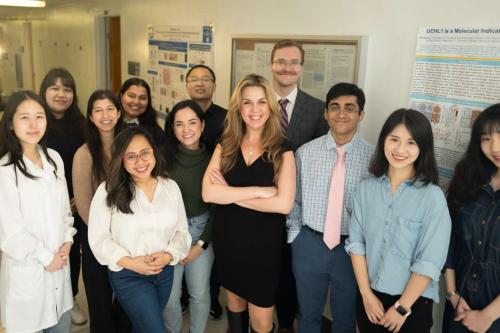
Protein identified as a potential biomarker and therapeutic target for aggressive neuroendocrine carcinomas
FINDINGS
Investigators from the UCLA Health Jonsson Comprehensive Cancer Center have identified a protein, called UCHL1, in highly aggressive neuroendocrine carcinomas and neuroblastoma that could potentially be used as a molecular biomarker for diagnosing these cancers and predicting and monitoring responses to therapy.
The team also found that using a UCHL1 inhibitor, either alone or in combination with chemotherapy, significantly delayed the growth and spread of neuroendocrine carcinomas and neuroblastoma in pre-clinical models.
“Our study demonstrates the therapeutic potential of targeting UCHL1 and its utility as a detection tool in neuroendocrine carcinomas and neuroblastoma in pre-clinical models creating a critical translational link between the study and the diagnosis and treatment of patients with these malignancies,” said Dr. Tanya Stoyanova, associate professor of molecular and medical pharmacology and urology at the David Geffen School of Medicine at UCLA and senior author of the study.
“In addition, we also revealed a detailed mechanism of action of UCHL1 and its role in regulating protein stability and nuclear import of proteins that regulate gene expression,” said first author Dr. Shiqin (Laura) Liu, a postdoctoral fellow in Dr. Stoyanova’s laboratory.
BACKGROUND
Neuroendocrine carcinomas, such as neuroendocrine prostate cancer and small-cell lung cancer, start in the cells that release hormones into the body and can develop in different organs, including the prostate and lung. Though they're not the most common type of cancer in those organs, cancers of this type often have a poor prognosis and limited therapeutic options. Current therapies for these cancers include combinations of chemotherapy, radiation and immunotherapy. Neuroblastoma is a type of cancer that most commonly occurs in young children and develops from immature nerve cells that often occurs in the adrenal glands, but it can also develop in nerve tissue along the spine, chest, abdomen, or pelvis. However, depending on the stage and risk groups, these treatments only extend patients’ survival for a few months, emphasizing the need for better therapeutic targets and minimally invasive approaches to diagnosing these malignancies.
METHOD
To identify druggable targets for neuroendocrine carcinomas and neuroblastoma, researchers first analyzed publicly available proteomics data and identified UCHL1 as one of the top druggable proteins. The team then investigated UCHL1 levels in tissues from patients with various types of neuroendocrine carcinomas and found elevated levels of UCHL1 in neuroendocrine prostate cancer, lung carcinoid, small cell lung cancer, neuroblastoma, and other neuroendocrine neoplasms. This suggested that UCHL1 may be a common target for drug development in neuroendocrine cancers based on its higher expression in these tumors compared to non-neuroendocrine tissues. The team then tested the therapeutic potential of blocking UCHL1 in pre-clinical models of neuroendocrine carcinomas and neuroblastoma.
IMPACT
This research can help guide the development of new minimally invasive blood-based tests to detect and monitor responses to therapies in patients with neuroendocrine carcinomas, such as highly aggressive neuroendocrine prostate cancer and small cell lung cancer, as well as neuroblastoma. This research also lays down the foundation for new clinical trials to test the inhibition of UCHL1 as a new treatment approach that could potentially help reduce deaths associated with the aggressive disease.
JOURNAL
The study was published in the journal Cell Reports Medicine.
AUTHORS
The senior author is Dr. Tanya Stoyanova, who is also a member of the UCLA Health Jonsson Comprehensive Cancer Center and the Eli and Edythe Broad Center of Regenerative Medicine and Stem Cell Research at UCLA. The study’s first author is Dr. Shiqin (Laura) Liu, a postdoctoral scholar in the Stoyanova laboratory. Other UCLA authors include Michelle Shen, Dr. Alifiani Hartono, Christopher Massey, Chung Lee and Dr. Arnold Chin.
Notes
This work was supported in part by the National Cancer Institute, the U.S. Department of Defense, and the UCLA Health Jonsson Comprehensive Cancer Center.

